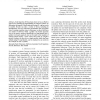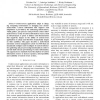1810 search results - page 62 / 362 » BASE: Using Abstraction to Improve Fault Tolerance |
PRDC
2009
IEEE
15 years 6 months ago
2009
IEEE
—Fault injection (FI) has been shown to be an effective approach to assessing the dependability of software systems. To determine the impact of faults injected during FI, a given...
PERCOM
2008
ACM
15 years 6 months ago
2008
ACM
Abstract—Context-aware applications adapt to changing computing environments or changing user circumstances/tasks. Context information that supports such adaptations is provided ...
TWC
2008
14 years 11 months ago
2008
Abstract-- This work proposes a novel fault-tolerant classification system based on distributed detection and two-dimensional channel coding. A rule is then derived to reduce the s...
CISS
2007
IEEE
15 years 6 months ago
2007
IEEE
— The problem of detecting encrypted information flows using timing information is considered. An information flow consists of both information-carrying packets and irrelevant ...
FPGA
2005
ACM
15 years 5 months ago
2005
ACM
FPGA-based designs are more susceptible to single-event upsets (SEUs) compared to ASIC designs. Soft error rate (SER) estimation is a crucial step in the design of soft error tole...


